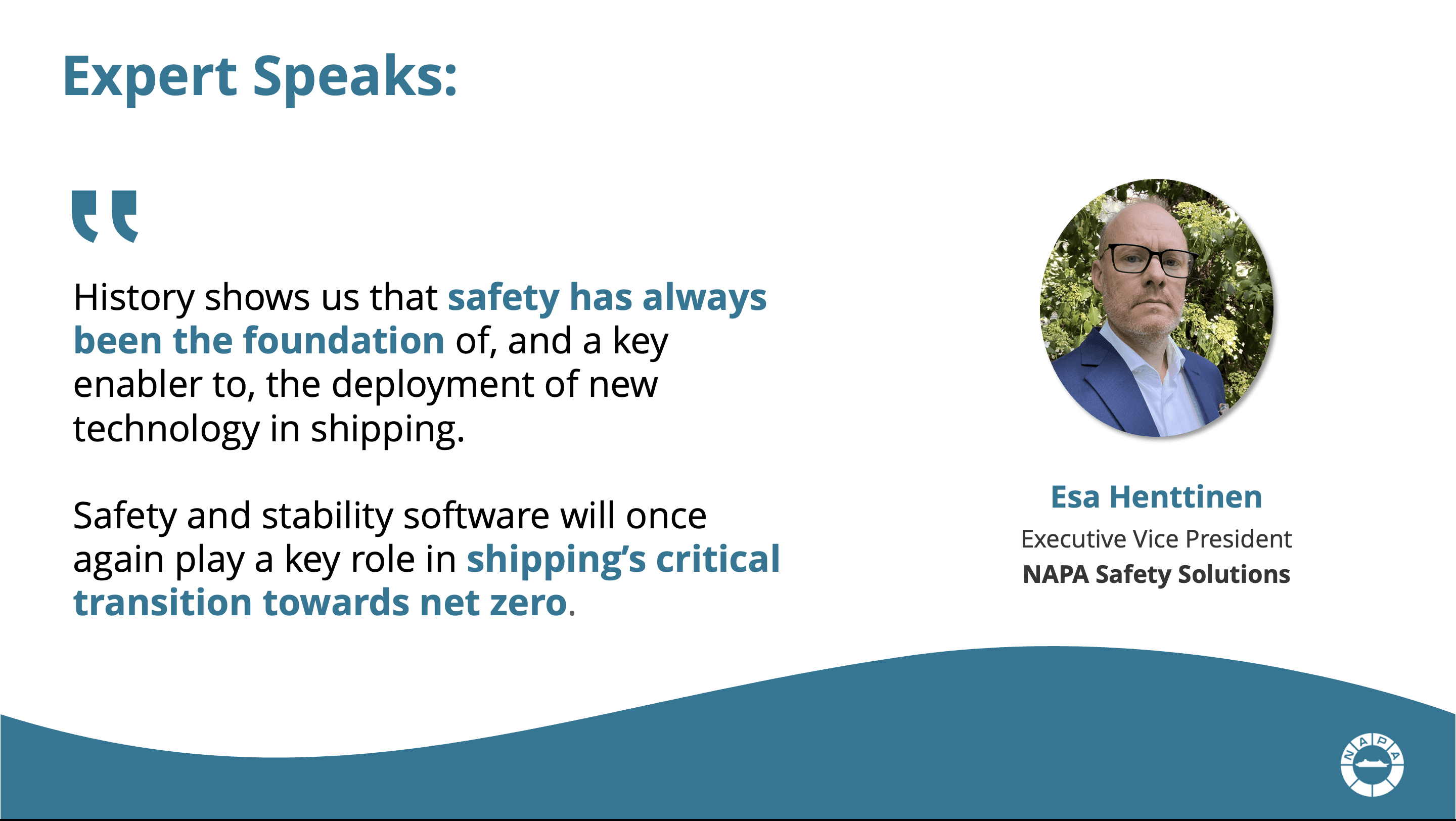October 26, 2022
Shipping’s safer route to decarbonization
Why ship safety and efficiency must work in tandem to win the race to net zero.

Shipping has come a long way from the safety horror stories, and the number of maritime incidents has decreased steadily in the past few decades. Yet, future fuels, carbon-capturing and new technologies needed for the race towards zero-carbon demand new safety frameworks – a paradigm shift in ship safety management and system integration. For a smooth green transition, ship safety and efficiency planning must become more proactive and collaborative. The good news is that digital platforms and data services already exist to facilitate it.
‘Move fast and break things’ was Mark Zuckerberg’s notorious motto from Facebook’s early days, suggesting that action was paramount and that in order to progress, you need to accept that some problems will occur. He has since distanced himself from the mantra after a wave of scandals; breaking things, it turns out, is a serious problem, and overlooking safety can have disastrous consequences in several industries.
Nowhere is this truer than shipping, where ensuring safety and stability are crucial in protecting the million seafarers and tens of thousands of passengers at sea at any given time. Meanwhile, as the maritime sector fast-tracks its decarbonization efforts, it will be rolling out lots of new technology, and fast, if it is to meet its responsibilities on climate change. ‘Make sure innovative initiatives don’t compromise safety’ might not sound as punchy as the early-2000s startup’s slogan, but it’s a far better mantra for ship owners and operators.
Does that mean that the shipping sector should lower its decarbonization ambitions? Not at all. This would miss an important point about the relationship between ship safety and efficiency; rather than a trade-off, they work together. In other words, technology developed to ensure safety and stability on board is an enabler of decarbonization solutions that the industry needs to put in place. Here’s how it works.
The decarbonization pressure is real and so are the safety needs
Knut Ørbeck-Nilssen, CEO of DNV Maritime, warns of a “safety gap” looming between “shipping’s existing safety-risk approach and ambitions for greater digitalization and the adoption of alternative, more environmentally friendly fuels,” writing in a 2021 report. Insurers UK P&I share the same view: “the green transition and need to adapt new practices and technologies quickly will inevitably lead to new risks.”
This “safety gap” contains a range of risks. At the top of the agenda, for most ship owners and operators, is the risk of machinery failure from the need to handle new future fuels such as ammonia, methanol, or hydrogen. There are also the risks of handling and storing new fuels – fire risks from fuels with different flashpoints, or potential toxicity to manage.
It doesn’t stop there; change one aspect of a vessel’s operations, and everything else is impacted too. When alternative fuels are introduced, the fuel-carrying capacity of a vessel, its stability and its optimization will be critical factors in voyage and safety planning.
LNG or electric vessels represent a significant difference in risk profile for shippers when compared with traditional ships and may require changes in vessel design, cargo loading procedures, intact stability, and damage stability management capabilities. Even changes that don’t involve hardware can introduce risk. Routing software needs to account for weather and stability risks at the same time as the need to save fuel, for instance. Connecting more devices to use data better creates heightened (but manageable) cyber risks, and thus demands better cyber resilience. Managing new risks and technologies is not unique to today’s decarbonization transition. History shows us that safety has always been the foundation of, and a key enabler to, the deployment of new technology in shipping.
Take changes in design, energy, hull and trim condition, for instance – stability software helps the industry ensure that the ship’s loading condition remains optimal, and that safety parameters such as longitudinal strength are maintained. Safety and stability software will once again play a key role in today’s critical transition towards sustainability.
Keeping ships safe and stable
As shipping is on a fast track to reducing its emissions, this means that all decarbonization activity needs to take stability and other risk factors into account right from the start.
This can happen thanks to the 3D models that power our stability solutions, which provide all partners, from company executives to crews, with a “safe framework” within which new emissions reduction measures can be implemented.
This helps ensure that the retrofitting of new systems, such as newer fuel-efficient engines, batteries, and wind propulsion systems, includes a comprehensive assessment of their effect on the vessel’s long-term safety profile. For instance, equipment such as exhaust gas cleaning systems (scrubbers) are often complex and heavy solutions requiring a thorough evaluation of ship stability and strength criteria when installed onboard. NAPA’s expertise in naval architecture and stability helps ship owners evaluate the effect on stability such changes may create.
Furthermore, with deadweight management, NAPA Stability can advise on how to adjust traditional safety margins (such as reducing fuels, ballast water etc.), to make voyages more efficient while still maintaining ship safety, stability, and other operational parameters – like ensuring the crew doesn’t run out of fuel during the voyage. By connecting the dots between a ship’s loading condition, logbook data from the deck, engine room waste management data, and tank and bunkering information, we can help identify the gaps in daily operational efficiencies, which gives actionable insights on where and how to optimize, while still sailing safely.
Another example is route optimization to save fuel. While merchant ships are adapting the best routes for maximum fuel efficiency, this might not be an option for the passenger ship segment, where they have to ply on a pre-defined route as per the itinerary. Here, operational optimization, such as deadweight management, becomes even more important for more energy-efficient sailing.

Knowledge is power
Greater awareness and the use of stability data, including trim and balance optimization, helps operate the ship in the most optimal way in terms of energy efficiency. For example, NAPA Stability ensures the safe and optimal planning of stowage, cargo and ballast to optimize the ship’s trim, thereby reducing fuel consumption. Here too, digital solutions help achieve the right balance and ensure that changes to a vessel’s trim to reduce emissions are not jeopardizing stability.
The impact of this goes beyond the implementation of new systems and routing technology. Reporting requirements are an important consideration for companies, both in terms of ensuring their regulatory compliance, and of demonstrating their own Environmental, Social and Governance (ESG) credentials. With the upcoming entry into force of IMO’s CII and EEXI requirements, and the need for greater transparency more generally, the value of accurate data collection and analysis is only becoming more apparent.
In this context, safety data collected through NAPA Logbook, for example, can also serve another purpose: easing ESG reporting. Some NAPA customers, like Columbia Cruise Services, are already using NAPA Logbook as a standardized data source for various environmental and technical reporting, which facilitates the life of the crew and improves accuracy, without disrupting the daily operations and processes they already have in place.
Safer Ships through Collaboration
Fundamentally, NAPA helps users manage risk by giving all parties, on board and onshore, a clearer, real-time picture of the risks they encounter at any given time. Ship-specific digital models, together with cloud-based solutions, enable crews on board and shoreside teams to collaborate on an unprecedented scale to ensure that the vessel is operated safely and efficiently. Cloud-based solutions achieve this by giving these teams greater visibility of a vessel’s stability situation in real time – making safety a shared responsibility, and enabling on-shore teams and emergency response services to intervene more quickly in case of an accident.
Stability and efficiency go hand in hand. A stable vessel is often an efficient one, and the same data that we use to optimize operations can also keep a ship safe (and vice versa).
Shipping has the tools to manage shipping’s green transition safely. There is no reason for a lack of ambition on either front.
Want to know more?
Get in touch with our experts to hear how NAPA can help you, or start by reading more about NAPA Stability.
